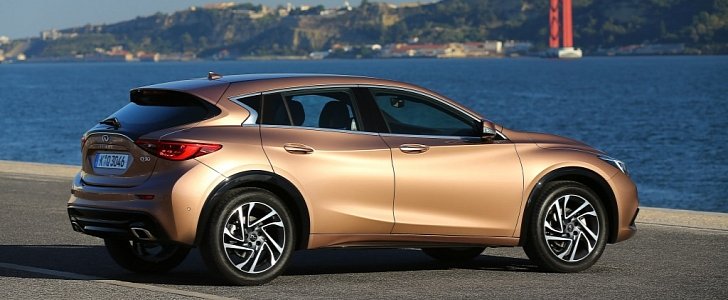Introduced in 2015 on the Mercedes-Benz GLA-Class' vehicle architecture, the Q30 and QX30 haven’t managed to sell as well as Infiniti predicted. In both Europe and the United States, sales slumped with each passing year.
The U.S. has the most telling example, with 14,093 examples of the QX30 sold in 2017 as opposed to 8,101 in 2018. Given these circumstances, not even Infiniti can claim the partnership with Mercedes-Benz for the compact hatchback has paid off.
Speaking at the 2019 Detroit Auto Show with Motor Authority, president Christian Meunier acknowledged the QX30 “is not a very successful product. We’ll keep selling it for now, but this is not a product that has a future beyond its current lifecycle.”
On the upside, the luxury division of Nissan plans to replace the Q30 and QX30 with “an all-Infiniti platform.” Nissan already has the CMF-C/D for the compact and mid-size segments, but chances are Infiniti could surprise us with a different platform. The QX50, for example, uses an “all-new platform” that's not shared with Nissan.
Manufactured in the United Kingdom (at the Sunderland assembly plant), the Q30 and QX30 are available with a 1.6- or 2.0-liter turbo plus 1.5- and 2.2-liter turbo diesel. Depending on the powerplant, the six-speed manual transmission can be changed with a seven-speed dual-clutch automatic.
Meunier offered a hint in regard to the suck-squeeze-bang-blow department of the succeeding models. As expected, the head honcho is trying to push the VC-Turbo on other models in the lineup.
Nissan also uses the VC-Turbo in the 2019 Altima, but as opposed to the 2.5, the range-topping engine option is FWD-only. To this effect, Canadian customers are offered the 2.5-liter DIG with Intelligent AWD as standard.
The Altima rides on the latest evolution of the Nissan D platform, which dates back to the third-generation Renault Laguna from 2007. The revisions brought to the vehicle architecture go beyond the safety suite and variable-compression engine. As a matter of fact, the Altima is 41 pounds lighter and 15 percent stiffer than the previous generation.
Speaking at the 2019 Detroit Auto Show with Motor Authority, president Christian Meunier acknowledged the QX30 “is not a very successful product. We’ll keep selling it for now, but this is not a product that has a future beyond its current lifecycle.”
On the upside, the luxury division of Nissan plans to replace the Q30 and QX30 with “an all-Infiniti platform.” Nissan already has the CMF-C/D for the compact and mid-size segments, but chances are Infiniti could surprise us with a different platform. The QX50, for example, uses an “all-new platform” that's not shared with Nissan.
Manufactured in the United Kingdom (at the Sunderland assembly plant), the Q30 and QX30 are available with a 1.6- or 2.0-liter turbo plus 1.5- and 2.2-liter turbo diesel. Depending on the powerplant, the six-speed manual transmission can be changed with a seven-speed dual-clutch automatic.
Meunier offered a hint in regard to the suck-squeeze-bang-blow department of the succeeding models. As expected, the head honcho is trying to push the VC-Turbo on other models in the lineup.
Nissan also uses the VC-Turbo in the 2019 Altima, but as opposed to the 2.5, the range-topping engine option is FWD-only. To this effect, Canadian customers are offered the 2.5-liter DIG with Intelligent AWD as standard.
The Altima rides on the latest evolution of the Nissan D platform, which dates back to the third-generation Renault Laguna from 2007. The revisions brought to the vehicle architecture go beyond the safety suite and variable-compression engine. As a matter of fact, the Altima is 41 pounds lighter and 15 percent stiffer than the previous generation.











